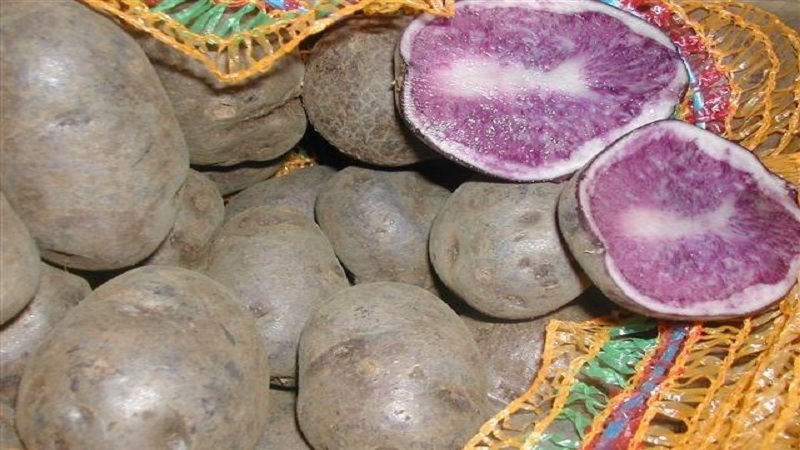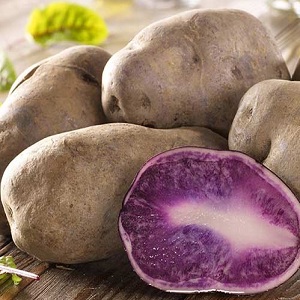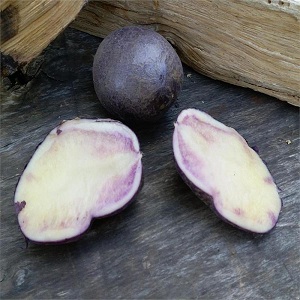Medium early table potato variety Gourmet purple
A distinctive feature of the Gourmet potato is the dark purple color of the peel and the purple color of the flesh with white splashes. In Russia, such varieties are considered exotic, but in European countries and the United States, the Gourmet variety has been actively used to prepare culinary masterpieces since the beginning of the 19th century.
Boiled fruits have a pleasant nutty aftertaste, contain a large amount of antioxidants that remove radionuclides from the body, are widely used in dietary nutrition due to their low starch content.
The content of the article
Origin and description of the variety
The exact origin of the purple potato has yet to be established. Biologists suggest that the variety is originally from South America (Bolivia, Peru). The Gourmet potato was recently introduced, it has not yet been entered into the State Register of Russia, and the data on the manufacturer has not been presented.
The SeDeK company is engaged in the sale of seed material. The culture is suitable for growing in any region of the country, but it feels best in the middle lane and in the south.
In the photo - Gourmet potatoes.

Distinctive features, appearance and yield are described in the table.
| Indicators | Characteristic |
|---|---|
| Ripening period | 80–90 days |
| Bush | Medium-sized, compact, up to 70 cm high |
| The number of tubers in the bush | 12–14 |
| Weight | 80-110 g |
| The form | Oval-rounded |
| Coloration | The peel is dark purple with small eyes, the pulp is purple with white veins |
| Leaves | Medium green |
| Corolla color | White with black stamens |
| Starch content | 13 % |
| Taste | Excellent, slightly unusual for potatoes |
| Cooking class / group | B / C (medium or strongly friable) |
| Yield | 350-400 c / ha |
| Marketability | 85–90 % |
| Keeping quality | 96 % |
| Appointment | High antioxidant table food |
| Sustainability | To scab and cancer, late blight of tops and tubers. The variety is susceptible to viral diseases |
| Transportability | High |
Agricultural technology varieties
The Gourmet variety is undemanding to care for, adapts to any climatic conditions. The maximum yield is shown in the regions of the middle zone and in the south of the country when cultivated on peaty, sandy loam and light loamy soils.
Agricultural rules provide for moderate watering, loosening, hilling and top dressing.
Timing, scheme and landing rules
The culture is characterized by a short growing season and demanding air temperature. Seed material is planted at rates not lower than + 10 ° C.
Gourmet potatoes are grown on slightly acidic, loose soils. If necessary, the soil is improved, guided by the following principles:
- Peaty, loamy, sandy loam soil is best suited for this variety. With an excess of sand, the soil is fertilized with manure or humus.
- Heavy loam is loosened with peat, river sand, rotted hay or sawdust. To maintain the airiness of the upper layer throughout the season, the soil is mulched.
- Sunny open areas are suitable for planting, but in the southern regions the beds are shaded with a special mesh or formed near shrubs.
- Lowlands with high humidity are not suitable for growing potatoes. In such conditions, the tubers suffer from fungal diseases. In regions with abundant and frequent precipitation, plantings are located on slopes with an unobstructed outflow of rainwater.
Large healthy tubers are used for planting.Small seeds are prepared according to the standard scheme (disinfection, soaking in growth stimulants, germination) and covered with thickening.
Tuber preparation rules:
- sorting seeds;
- disinfection in Fitosporin, Bordeaux liquid - 40–60 min;
- germination in a bright room at a temperature not lower than +15 ° С with spraying with clean water once every 3-4 days.
Strong shoots 1 cm long indicate that the tubers are ready for planting. Too long seedlings are shortened, thin ones break off. Immediately before planting, the seeds are soaked in "Zircon" or "Epin".
For 2-3 days, the tubers are taken out into the street and laid out in partial shade for warming up. On the site, holes are formed with a depth of 5-10 cm at a distance of 40 cm. The row spacing is 60 cm. Small tubers are sealed with an interval of 30 cm.
It is interesting:
Care
Plants react painfully to both deficiency and excess of moisture. For the first time, the earth is moistened after friendly shoots, the second time - during the flowering period. In drought, the frequency of watering is doubled.
Reference. With an excess of water, the potato becomes fresh, with a deficit, the tubers grow small.
Loosening and weeding is carried out after each watering. The beds are treated superficially, trying not to damage the roots and tubers. Mulching will help to facilitate planting care. Hay or straw prevents rapid evaporation of moisture and weed growth.
Hilling is an important agricultural technique, without which it is impossible to get a rich harvest. The procedure promotes the growth of the root system, prevents drying out of the soil and stems. Early hilling protects the bushes from the cold in unstable climatic conditions. The first shoots are completely covered with earth.
Repeated manipulation is carried out taking into account the growth rate of the bushes before the budding stage. Sprinkle the stems with ½ growth wet soil. Additional hilling is required during the period of tying tubers, which must be covered from direct sunlight.
It is convenient to combine top dressing with irrigation. The soil is moistened with clean water, then watered with mineral compounds. Superphosphate, ammonium nitrate, urea, potassium chloride, nitrophosphate are used as top dressings.
The root dressing scheme is presented in the table
| Application time | Fertilizer (per 1 m²) | |
|---|---|---|
| I feeding | During the period of growing green mass | 20 g ammonium nitrate, 20 g potassium sulfate |
| II feeding | During budding | 1 tbsp. l. urea, 20 g potassium sulfate / 10 l water |
| III feeding | During flowering | 40 g superphosphate / 10 l water |
Foliar dressing scheme:
| Application time | Fertilizer (per 1 m²) | |
|---|---|---|
| I feeding | During the period of growing green mass | 100 g urea, 150 g potassium monophosphate, 5 g boric acid / 5 l water |
| II feeding | During flowering | 1 kg of nettle / 3 l of water (leave for 24 hours) + 30 g of shavings of laundry soap |
| III feeding | After flowering | 10 g superphosphate / 1 l water |
Important! Foliar dressing is carried out in the evening to avoid sunburn on the foliage.
The nuances of growing and possible difficulties
There are no difficulties with growing purple potatoes. Subject to the temperature regime during planting, the rules for further caring for the bushes, it is possible to get a rich harvest.
Experienced farmers recommend paying attention to the method of cultivating potatoes in homemade open boxes made of boards or bricks. The height of the sides is 20 cm, the width is 1 m. Straw, hay, mown grass are laid out at the bottom, compost and soil from the aisles are placed on top.
When planting tubers, the soil is not dug up, since there is organic matter at the bottom, which it is advisable not to touch. Only surface loosening of the soil is carried out. Two rows are formed in the box, and the pits are placed at a distance of 30 cm. They are planted in a checkerboard pattern. Ash, chicken egg shell powder are placed on top of the seeds and sprinkled with soil.As soon as the bushes appear, the beds are weeded and mulched with straw or hay.
Diseases and pests
Purple Gourmet potatoes are resistant to scab and potato crayfish, late blight of tops and tubers, but susceptible to viruses that cause leaf curling and columnar wilting, mottling, and deformation of tubers.
The table contains signs of infection and control methods.
| Name of the disease | Signs | Fight |
|---|---|---|
| Rolling the leaves | The lower leaves dry and curl up in a tube along the central vein, acquire a red-violet tint, and net necrosis appears on the tubers. |
|
| Speckled mosaic | The bushes do not lag behind in development, but light specks appear on the leaves. | |
| Post wilt | Yellowing of leaves at the edges, slowing growth, small foliage curls in a groove, acquires a purple hue. | |
| Gothic | The edges of the leaves acquire an anthocyanin coloration, the tubers take on an ugly shape. |
Important! There is no specific treatment for viral diseases, so high-quality prevention is important.
Potato plantings are often attacked by spider mites, aphids, cicadas, and the Colorado potato beetle. The table shows ways to get rid of pests on the site.
| Pest | Control methods |
|---|---|
| Aphid | Spraying with insecticides Aktara, Confidor, Aktellik, Danadim, infusion of onion peels (200 g of dry raw materials, 50 g of soap shavings / 5 liters of water). |
| Spider mite | Treatment with tobacco shag infusion (400 g of raw materials, 25 ml of liquid soap / 10 l), preparations Vertimek, Bicol. |
| Cicada | Irrigation of bushes with means of Movento Energy, Tabu, Akarin, Calypso, Proteus. |
| Colorado beetle | Spraying with infusion of sunflower flowers (500 g of raw material / 10 l of water, leave for 3 days), fungicides "Colorado potato beetle NO!", "Aktara", "Killer", "Corado", "Ultor", dusting with birch ash (10 kg / 100 m2). |
Collection, storage and use of the crop
The first digging of young tubers is carried out 1.5 months after full germination. In the southern regions, a crop is harvested that has reached full technical ripeness after 100-110 days.
The harvested potatoes are suitable for winter storage in a cool place (cellar, basement, glazed balcony). The material is immediately selected for further planting in the spring and a landscaping procedure is carried out. Tubers are laid out in one layer on a flat surface and kept in a bright place for 10-15 days, but not in direct sunlight. This prevents the germination of tubers in winter, accelerates germination, and increases the defenses.
Purple potatoes have an unusual taste, when boiled, they acquire a nutty flavor and become almost black. The product is suitable for preparing raw salads, cooking, baking. Deep purple mashed potatoes will impress your guests.
Advantages and disadvantages
The advantages of Gourmet potatoes include:
- attractive appearance of tubers;

- unusual color of the pulp;
- great taste;
- high keeping quality and marketability;
- versatility in cooking;
- resistance to fungal diseases;
- high productivity;
- unpretentious care.
Among the disadvantages:
- exactingness to the air temperature during landing;
- predisposition to viral diseases.
Farmers reviews
Gourmet potatoes have not yet become widespread in our country, but those who have already tried to plant the variety on their site were satisfied with the result.
Evgeniya, Chekhov: «The unusual purple potato was first seen on the market. Interested in growing, I bought seeds and planted several bushes in the country. I tried adding raw potatoes to salads, I really liked the taste, slightly sweetish, non-starchy. "
Inna, Nizhny Novgorod: “Purple potatoes were advised by my nutritionist, citing low starch content. I bought some seeds at the market and planted them in the garden. Culture loves warmth, ripens early. The care is simple, like for ordinary potatoes. "
Read also:
A popular variety of potatoes with excellent taste and good keeping quality "Kievsky Svitanok".
Conclusion
Given the recent appearance of the Gourmet variety on the domestic market, only a few farmers and consumers have managed to appreciate its quality. But those who tried to grow potatoes on their site respond positively about it. The culture does not require special care, but shows the maximum result when cultivated in soil, generously flavored with mineral compounds.
The main disadvantage of the Gourmet is susceptibility to viral lesions, against which no effective drugs have yet been invented. Agrotechnical methods will help prevent diseases: crop rotation, seed treatment before planting, weed harvesting, insect control.